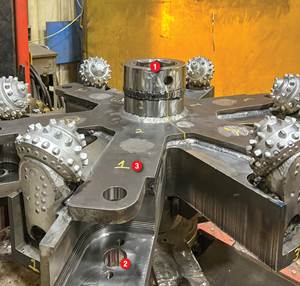What Is Single-Lobe Peeling?
A manufacturer of large turn-mill machines has developed a bar-peeling process to complete large, progressive cavity pump rotors in one setup.
Share



A progressing cavity pump (PCP) is a special type of rotary positive-displacement pump in which the fluid is displaced axially at a constant rate. PCPs comprise two helicoidal gears (rotor and stator), in which the rotor is positioned inside the stator. Rotors are typically machined from high-strength steel and coated with a material that resists abrasion and reduces stator/rotor friction.
Single-point machining is not an option to machine these long and relatively thin rotors because cutting tool pressure can cause the parts to deflect. Conversely, using bar-peeling heads enables the barstock to be held stationary to balance the cutting forces.
Bar peeling is not a new concept, but it is one of the most demanding of all machining operations due in part to large cutting depths. Bar peeling is a kinematically reversed, longitudinal, round-turning process in which the workpiece passes through a rotating tool, the peeling head, that is fitted with cassettes with indexable inserts. The process requires enormous amounts of lubricant for effective cooling and chip flushing, and the high loads can cause vibration or guide problems. In addition, the materials used for the PCP rotors, commonly stainless steel and nickel-based alloys, are challenging to machine.
Machine tool builder Weingärtner calls the bar-peeling process for its Vario universal machines “single-lobe peeling” (this is shown in the video below). Weingärtner’s single- lobe, bar-peeling process is designed to machine parts as long as 12 m to surface finishes of 0.8 micron Ra or less.
According to the company, the challenge lies in adjusting the process parameters and the application-specific tuning of the indexable inserts. In most cases, this is done in close cooperation with the cutting tool manufacturer, taking the composition of cutting materials and geometries into account, such as length of cutting edge, chip geometry and supporting chamfer.
Bar peeling is heavy-duty machining, economically done in a diameter range from 20 to 500 mm. The feed rate for standard materials ranges to 18 mm/min., which is several times the feed rate possible in general turning. Cutting depths ranging to 15 mm are achieved with the proper cassette systems.
Up To 12 Cutting Edges in Action
Weingärtner has developed its own cutting head for its single-lobe bar-peeling process, which is easy to adjust and change, the company explains. The cutting head features as many as 12 cutting edges and is excentrically aligned to the workpiece. The excenter and longitudinal feed of the peeling head in relation with the workpiece rotation is required to produce the correct profile of the workpiece. To accommodate a peeling process with as many as 12 cutting edges, which is comparable to turning with 12 toolholders in one pass, the drive unit features a drive power of up to 100 kW.
The machine’s C axis is responsible for the exact rotation of the workpiece in interpolation with the Z axis. This accurate interpolation determines the lead (pitch) of the workpiece, which is one of the critical parameters for the efficiency of the PCPs. The C axis is driven by high-ratio and backlash-free drive systems to withstand the extreme torque that is applied to the workpiece by the peeling head. The multiple cutting edges try to rotate the workpiece, so the C axis has to resist this force and maintain the proper rotational speed interpolated to the Z-axis longitudinal movement of the peeling head, Weingärtner explains.
To avoid vibration due to the high cutting forces, the machines feature damping cylinders, V-block steady rests and workpiece support every two to three meters to avoid sagging. Moreover, the machine has a rigid slant-bed design to minimize vibration and achieve good surface finishes. The slant-bed design also improves chip evacuation and ergonomics for the operator, Weingärtner says. For programming, the company offers a parameter-based software directly on the machine or offline on a computer to generate the CNC program.
Related Content
Select Machining Technologies Highlights Multitasking Machines
IMTS 2024: Select Manufacturing Technologies is highlighting large-capacity multitasking machines from Solace, Geminis, Ibarmia and Momentum.
Read MoreHow a Custom ERP System Drives Automation in Large-Format Machining
Part of Major Tool’s 52,000 square-foot building expansion includes the installation of this new Waldrich Coburg Taurus 30 vertical machining center.
Read MoreThe Cut Scene: The Finer Details of Large-Format Machining
Small details and features can have an outsized impact on large parts, such as Barbco’s collapsible utility drill head.
Read MoreInside a CNC-Machined Gothic Monastery in Wyoming
An inside look into the Carmelite Monks of Wyoming, who are combining centuries-old Gothic architectural principles with modern CNC machining to build a monastery in the mountains of Wyoming.
Read More


















.png;maxWidth=300;quality=90)






